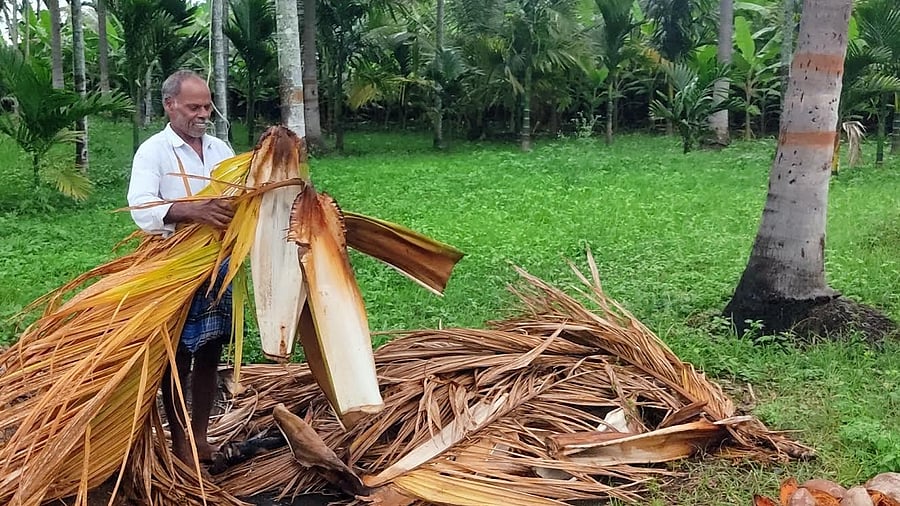
As entrepreneurs explore diverse products, the demand for areca sheaths is growing.
India is the world’s leading producer, consumer and even importer of areca nut, which is cultivated mainly in the southern and the northeastern states. While India accounts for over 60% of the global output, Karnataka alone contributes around 70% of the country’s production.
The prized Sirsi Supari from Uttara Kannada, known for its distinctive flavour, shape and texture, remains the only areca nut variety in India to have earned the coveted Geographical Indication (GI) tag.
“For centuries, areca nut palms have been cultivated in areas with well-drained soil in Karnataka’s Malnad region which enjoys a warm-humid climate and abundant rainfall. With expanding irrigation facilities, cultivation has now spread to other parts of the state,” says Athirath Biluve, a fourth-generation areca nut grower from Shivamogga.
While the areca palm has long been valued for its nut consumed with betel leaves and used in religious rituals, social customs and cultural practices, it is now at the centre of an entrepreneurial wave. Researchers, entrepreneurs and artisans are exploring the innovative uses for every part of the palm, from leaves and husks to sap and timber.
Footwear made of areca leaf sheath.
“Areca palm byproducts offer a sustainable and eco-friendly alternative to many commonly used products. From furniture to leather, the possibilities are immense,” says journalist and farmer Shree Padre, who has long advocated for sustainability.
One of the most visible byproducts is areca leaf tableware — sturdy and biodegradable plates, bowls and cutlery made from fallen palm leaves sheath. The sheaths are collected, cleaned and heat-pressed into shape using moulds. Free of chemicals, these products are fully compostable, freezer/microwave-safe and a popular alternative to single use plastic and paper tableware.
Natural dye
Another byproduct with growing potential is chogaru, a concentrated red liquid obtained during the processing of the red areca nut variety, mainly grown in Malnad region. Rich in tannins, chograu is generally discarded but textile artisans are now turning it into a natural dye.
Vegan leather handbags made of leaf sheaths of areca palms.
“Chogaru yields shades ranging from maroon and garnet to brown. It works beautifully on natural fabrics like cotton, silk and wool,” says Terence Peter of Charaka, a Cooperative Weavers’ Society in Shivamogga. The cooperative purchases chogaru from farmers at Rs 100 per litre, creating an additional income stream.
Chogaru dye is also being used for tanning leather.
Repurposing into timber
Mature areca palms which grow over 50 feet tall, can also be repurposed into timber once they die of natural causes or disease.
“Areca nut timber is strong and durable,” notes Santosh Kumar, an entrepreneur from Sagara, who crafts furniture and decor items from the wood.
“Decades back, the trunk was used to build attics but in recent years it was being discarded as waste. Now, we are turning them into furniture and other products,” he says.
Footwear, handbag, purses, diaries and more are now made using areca leaf sheath and its byproducts.
Santosh makes benches, wall panels, wall partitions, easy-to-install picket fences and decor items from areca nut palm. However, Santosh said, working with areca nut timber is not easy as it requires specialised machinery and trained hands.
Santosh sees immense potential in converting areca nut timber to plywood, highlighting the need for more research and development.
Organic manure
Areca leaves and husks, once burned as waste, have found new life as organic manure. “We mix dried leaves and husk with cow dung to prepare a slurry, then add red earthworms (Eisenia fetida) to create vermicompost,” explains Ravi K G, team manager of Mysuru-based Surabhi Plantech.
The process of preparing manure takes about four months. “The manure, if stored well, has no expiry and is more cost-effective than chemical fertilisers,” Ravi adds.
Rise of vegan leather
In another example of innovation, the leaf sheaths of areca palms are now being transformed into vegan leather.
“Plant latex is used as a base for this vegan leather. Areca fibres have excellent texture and strength though the small size of the sheaths is a challenge,” says Shivamogga’s Suresh S R, an entrepreneur and patent holder in this emerging field.
Combining cotton with areca fibre yields PeTA-certified biodegradable leather that rivals animal hide in durability and flexibility. “It has good tensile and shear strength, and is water-efficient with lower carbon emissions,” Suresh says.
The material can mimic the texture of snake or elephant skin and is currently used to make wallets, handbags, slippers and diary covers.
Spirited innovation
The areca nut has even found its way into the world of winemaking. Talisva Wines based out of Shivamogga, founded by Sushma Sanjay and her son Akarsh Sanjay, has created a paan-flavoured wine blending honey, betel leaves and areca nut.
“Chewing paan is part of our culture but younger people find it inconvenient and unappealing. We thought, why not reimagine it as a drink?” says Akarsh. The result is a sweet and spicy wine with 9% alcohol and the distinct aroma of betel leaf.
Sustainable efforts
Despite being the world’s largest producer, India still uses areca nut mainly for chewing and rituals. In contrast, countries in Southeast Asia have diversified its use, especially for its medicinal properties. Areca nut flavoured toothpaste, ice creams, squash apart from its use as an adhesive material are some of the other potential uses.
“We need to learn from them and diversify our approach,” says Shree Padre.
“Diversification, research and commercialisation are crucial. Any new discovery or invention generally culminates with paper publication and does not enter the market. With sustained support and proper funding, areca can become not just a crop but a symbol of a circular, sustainable economy,” he adds.
According to experts, the adoption of sustainable and eco-friendly products has been slow, mainly due to low awareness and higher price point.